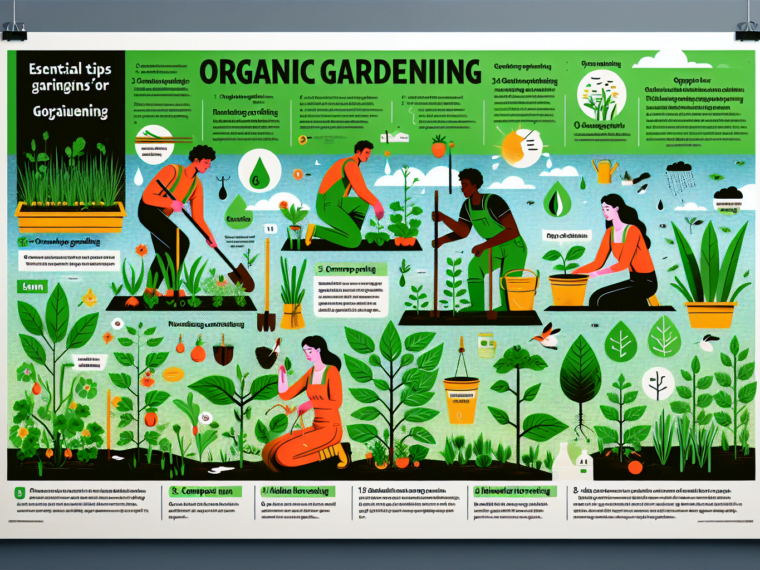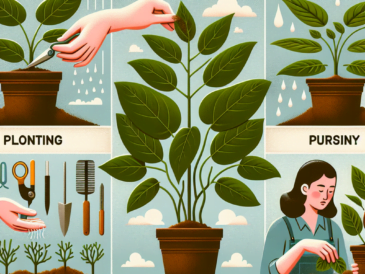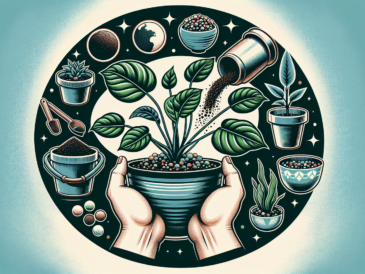Overview of Organic Gardening
When it comes to organic gardening, there are significant differences from conventional methods. Instead of relying on synthetic fertilizers and pesticides, organic gardeners nurture the soil with natural amendments like compost and manure, which support healthy plant growth. Additionally, they prioritize biodiversity and use natural predators to manage pests, maintaining a balance within the ecosystem.
Importance of Sustainable and Natural Growing Methods
The significance of sustainable and natural growing methods cannot be overstated. By avoiding harmful chemicals, organic gardening promotes the well-being of not only individuals but also wildlife and the broader environment. It encourages a harmonious relationship between humans and nature, working with the earth rather than against it.
The Importance of Soil Health in Organic Gardening
Soil plays a crucial role in facilitating plant growth. It provides the necessary nutrients, moisture, and support for plants to thrive. Understanding the intricacies of soil health is vital for successful organic gardening.
The Role of Soil in Plant Growth
Healthy soil is essential for nourishing plants and promoting their overall well-being. A nutrient-rich soil provides the foundation for robust growth, enabling plants to develop strong roots and ample foliage. Moreover, it fosters the production of vibrant and healthy fruits and vegetables.
Techniques for Enhancing Soil Fertility and Structure
To maximize soil fertility and structure, organic gardeners utilize various techniques such as composting and incorporating natural amendments. These methods aid in replenishing essential nutrients, improving soil texture, and enhancing its water retention capacity.
Composting and Soil Amendments
Composting presents a sustainable approach to amending soil. It involves the decomposition of organic matter to create nutrient-dense compost that enriches the soil. Additionally, selective use of natural amendments tailored to specific plant requirements contributes to maintaining optimal soil health.
When it comes to organic gardening, plant selection and planning are crucial aspects for a successful outcome. Choosing suitable plant varieties for organic growing is the first step in this process. It’s important to select plants that thrive in your specific climate and soil conditions, as they will require less maintenance and overall care. Additionally, considering crop rotation and companion planting can greatly benefit the health and productivity of your garden. This not only helps prevent the depletion of soil nutrients but also encourages natural pest control and healthier plant growth. When designing your garden layout, aim for productivity and efficiency. Utilize space effectively by grouping plants with similar needs together and ensuring easy access for maintenance tasks. Planning ahead and implementing these strategies will contribute to a bountiful harvest.
When it comes to organic gardening, getting your plants off to a strong start is crucial. Seed starting techniques play a vital role in the success of your garden. Whether you use trays with individual cells or small pots, the goal is to provide the right environment for germination. Using a little bottom heat can speed up the process and enhance germination rates.
A Little Bit About Seed Starting Techniques
A little bit of moisture goes a long way in helping seeds get a good start. Covering them lightly with a bit of vermiculite or sand can help retain moisture levels while allowing air to reach the seeds.
Transplanting and Caring for Young Plants
Once your seeds have sprouted, the next step is transplanting and caring for young plants. Proper handling during this stage can make a big difference in the health and vigor of your plants.
Caring for Young Plants: A Brief Overview
It’s important not to let seedlings become leggy as they’re growing; ensuring they get enough light helps prevent this issue. A little bit of gentle fan action can help strengthen their stems as well.
Proper Spacing and Depth for Planting
Proper spacing and depth for planting are critical factors that influence plant growth and yield. Inadequate spacing can lead to competition for resources, while planting too deeply may slow down or even stop germination entirely.
The Importance of Proper Spacing and Depth
Providing sufficient space between plants allows for better airflow, which reduces the risk of disease. Paying attention to planting depth is equally important; as a general rule, seeds should be planted two to three times as deep as their width.
When it comes to managing pests in your organic garden, there are a variety of natural methods that can be employed. One little-known strategy for controlling pests is the use of companion planting, where certain plants are grown together to help deter pests. Natural predators, such as ladybugs and praying mantises, can also be introduced to keep pest populations in check. Additionally, homemade remedies like garlic spray or neem oil can be effective at repelling unwanted insects.
Preventative Measures
Preventative measures play a crucial role in disease management in an organic garden. Ensuring proper plant spacing and adequate air circulation can help prevent the spread of diseases. Good hygiene practices, such as regularly cleaning tools and removing any diseased plants promptly, can also help minimize the risk of disease outbreaks. Using disease-resistant plant varieties is another proactive measure that can reduce the likelihood of infection.
Integrated Pest Management
An integrated pest management approach involves utilizing a combination of strategies to address pest issues in a holistic manner. This includes monitoring pest populations to determine if action is necessary and employing cultural practices, like crop rotation, to disrupt pest cycles. When intervention is required, less harmful control methods, such as trapping or hand-picking pests, should be utilized before considering more drastic measures like the use of organic pesticides as a last resort.
One of the crucial aspects of organic gardening is efficient watering techniques. Using sustainable water sources such as rainwater can significantly benefit your garden. Additionally, implementing water-saving methods like drip irrigation is essential to maintain a thriving organic garden while conserving water resources.
A. Efficient watering techniques for organic gardens
It is necessary to utilize efficient watering techniques in organic gardens. This involves understanding the specific water needs of different plants and adjusting watering schedules accordingly. By ensuring that plants receive just the right amount of water, gardeners can promote healthy growth without wasting this valuable resource.
B. Using rainwater and other sustainable water sources
An eco-friendly approach to watering involves harnessing rainwater and utilizing other sustainable water sources for gardening purposes. Rainwater harvesting systems can be set up to collect and store rainwater, providing a natural and readily available supply for nurturing plants in the garden.
C. Drip irrigation and other water-saving methods
Incorporating drip irrigation and other water-saving methods is crucial for organic gardening. Drip irrigation systems deliver small amounts of water directly to the base of plants, reducing wastage and ensuring that moisture reaches the root zone where it is needed most. Implementing these water-saving practices helps conserve water while promoting healthy plant growth in an organic garden.
A. Timing and techniques for harvesting plants
When it comes to harvesting your plants, timing is crucial. Different vegetables and fruits reach their peak ripeness at different times, so it’s important to keep an eye on them. For example, tomatoes should be picked when they are fully colored but still firm to the touch, while lettuce is best harvested in the early morning before the sun beats down on it.
Make use of good gardening shears or a sharp knife to carefully collect your produce without damaging the plant or fruit itself. Always handle your harvest with care and avoid bruising or crushing them.
B. Proper handling and storage of harvested produce
Once you’ve harvested your crops, proper handling and storage are essential for maintaining their freshness and taste. It’s essential to sort through your produce, removing any damaged or overripe items, as these can cause spoilage of the rest of the harvest if left unchecked. After sorting, delicate fruits like berries should be stored in a single layer to prevent bruising, while root vegetables such as carrots and beets should be stored in perforated plastic bags to maintain humidity levels without trapping moisture. Always remember to store your produce in a cool, dark place, as exposure to light can cause them to spoil more quickly.
C. Maximizing shelf life and preserving freshness
Extend the shelf life of your freshly harvested produce by following some simple yet effective storage practices. For instance, leafy greens like spinach and kale stay fresh longer when wrapped in a damp paper towel and placed in a plastic bag before being refrigerated, helping to retain their crispness and flavor. Additionally, certain vegetables like bell peppers do well when stored whole rather than chopped, as exposing the cut surface can accelerate spoilage. By utilizing these techniques for storing your crops, you can ensure that they remain at their best for as little longer with minimal loss of quality.
When it comes to extending the growing season, there are a variety of techniques that can be used. Cold frames and row covers can provide a little extra time for plants on either end of the growing season, protecting them from frost. Designing and managing a greenhouse for organic production offers another opportunity to extend the growing season by creating a controlled environment. Such methods help ensure that your plants stay flourishing even when the weather outside is less than ideal.
Techniques for Extending the Growing Season
Using cold frames and row covers can be an effective technique for extending the growing season. These structures offer protection against harsh weather conditions, allowing plants to continue thriving even when temperatures drop. By providing an extra layer of insulation, you can create a microclimate that encourages plant growth.
Designing and Managing a Greenhouse
A greenhouse designed for organic production offers the opportunity to create a controlled environment for your plants. With careful management, you can extend the growing season and protect your crops from adverse weather conditions. It is important to consider factors such as ventilation and humidity control to ensure optimal growing conditions within the greenhouse.
Using Cold Frames and Row Covers
Cold frames and row covers are valuable tools for season extension in organic gardening. They provide a layer of protection from harsh weather conditions, enabling plants to thrive despite temperature fluctuations. By incorporating these techniques into your gardening practice, you can maximize your growing season and boost overall productivity.
When it comes to marketing and selling surplus organic produce, there are several strategies that can be employed. Firstly, considering setting up a roadside stand or participating in local farmers’ markets can help connect with potential customers. Additionally, reaching out to local restaurants, grocery stores, and co-ops can open up avenues for selling excess produce. Implementing a community-supported agriculture (CSA) program may also be an effective way to sell directly to consumers who value organic products.
Understanding Local Markets and Consumer Preferences
Understanding the local market and consumer preferences is crucial for successfully selling organic produce. Researching what types of fruits, vegetables, and herbs are in demand within the community can help tailor production to meet those needs. Additionally, recognizing the importance of organic certifications and labeling can attract customers who prioritize sustainability and health.
Building Relationships with Customers and Retailers
Building relationships with customers and retailers is essential for long-term success in selling organic produce. Engaging with customers at farmers’ markets or through social media platforms can create a loyal customer base. Additionally, fostering partnerships with retailers by providing consistent supply and high-quality products can lead to recurring sales opportunities.




